- 1 Introduction
- 2 Import the libraries
- 3 Data pre-processing
- 4 Feature Extraction with Data Augmentation
- 4.1 Name Definitions
- 4.2 Parameter Settings
- 4.3 Instantiating the VGG19 convolutional base
- 4.4 Freezing all layers up to a specific one
- 4.5 Instantiating a densely connected classifier
- 4.6 Callbacks
- 4.7 Fitting the model
- 4.8 Obtaining the best model values
- 4.9 Obtaining class assignments
- 4.10 Validation
- 4.11 Load best model
- 4.12 Model Testing
- 4.13 Test Out of the Box Pictures
- 5 Conclusion
1 Introduction
In my post Computer Vision - CNN with Transfer Learning I showed how to train a binary image classifier with the help of a pre-trained neural network. Now I would like to improve this model by means of Fine Tuning.
I will again use the pre-trained network VGG19 from the Keras applications provided.
For this publication I used the images from the cats and dogs dataset from the statistics platform “Kaggle”. You can download the used data from my “GitHub Repository”.
2 Import the libraries
from preprocessing_CNN import Train_Validation_Test_Split
import numpy as np
import pandas as pd
import os
import shutil
import pickle as pk
import cv2
import matplotlib.pyplot as plt
%matplotlib inline
from keras import layers
from keras import models
from keras.callbacks import EarlyStopping, ModelCheckpoint
from keras.preprocessing.image import ImageDataGenerator
from keras.models import load_model
from keras.applications import VGG193 Data pre-processing
How the data for a CNN model training must be prepared I have already explained in this post: Computer Vision - Convolutional Neural Network
The exact functionality of the code I have explained in this post: Automate the Boring Stuff
Please download the two folders cats and dogs from my “GitHub Repository” and navigate to the project’s root directory in the terminal. The notebook must be started from the location where the two files are stored.
3.1 Train-Validation-Test Split
For this please download the preprocessing_CNN.py file from my “GitHub Repository” and place this file next to the folders cats and dogs and start your Jupyter notebook from here.
c_train, d_train, c_val, d_val, c_test, d_test = Train_Validation_Test_Split('cats', 'dogs')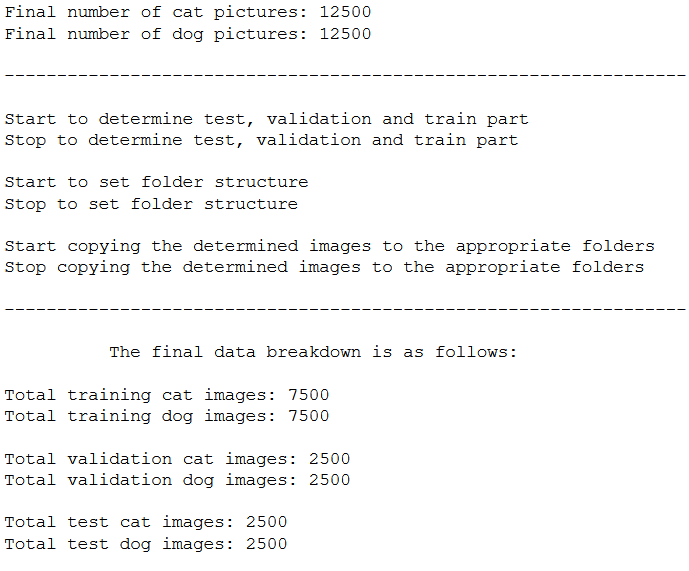
3.2 Obtaining the lists of randomly selected images
list_cats_training = c_train
list_dogs_training = d_train
list_cats_validation = c_val
list_dogs_validation = d_val
list_cats_test = c_test
list_dogs_test = d_test3.3 Determination of the directories
root_directory = os.getcwd()
train_dir = os.path.join(root_directory, 'cats_and_dogs\\train')
validation_dir = os.path.join(root_directory, 'cats_and_dogs\\validation')
test_dir = os.path.join(root_directory, 'cats_and_dogs\\test')3.4 Obtain the total number of training, validation and test images
num_cats_img_train = len(list_cats_training)
num_dogs_img_train = len(list_dogs_training)
num_train_images_total = num_cats_img_train + num_dogs_img_train
print('Total training cat images: ' + str(num_cats_img_train))
print('Total training dog images: ' + str(num_dogs_img_train))
print()
print('Total training images: ' + str(num_train_images_total))
num_cats_img_validation = len(list_cats_validation)
num_dogs_img_validation = len(list_dogs_validation)
num_validation_images_total = num_cats_img_validation + num_dogs_img_validation
print('Total validation cat images: ' + str(num_cats_img_validation))
print('Total validation dog images: ' + str(num_dogs_img_validation))
print()
print('Total validation images: ' + str(num_validation_images_total))
num_cats_img_test = len(list_cats_test)
num_dogs_img_test = len(list_dogs_test)
num_test_images_total = num_cats_img_test + num_dogs_img_test
print('Total test cat images: ' + str(num_cats_img_test))
print('Total test dog images: ' + str(num_dogs_img_test))
print()
print('Total test images: ' + str(num_test_images_total))
4 Feature Extraction with Data Augmentation
4.1 Name Definitions
checkpoint_no = 'ckpt_1_CNN_with_TFL_VGG19_FineTuning'
model_name = 'Cats_Dogs_CNN_TFL_VGG19_FineTuning_epoch_30'4.2 Parameter Settings
img_height = 150
img_width = 150
input_shape = (img_height, img_width, 3)
n_batch_size = 32
n_steps_per_epoch = int(num_train_images_total / n_batch_size)
n_validation_steps = int(num_validation_images_total / n_batch_size)
n_test_steps = int(num_test_images_total / n_batch_size)
n_epochs = 30
print('Input Shape: '+'('+str(img_height)+', '+str(img_width)+', ' + str(3)+')')
print('Batch Size: ' + str(n_batch_size))
print()
print('Steps per Epoch: ' + str(n_steps_per_epoch))
print()
print('Validation Steps: ' + str(n_validation_steps))
print('Test Steps: ' + str(n_test_steps))
print()
print('Number of Epochs: ' + str(n_epochs))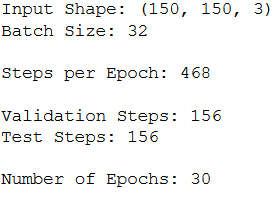
4.3 Instantiating the VGG19 convolutional base
VGG19_base = VGG19(weights='imagenet',
include_top=False,
input_shape=input_shape)
conv_base = VGG19_baseconv_base.summary()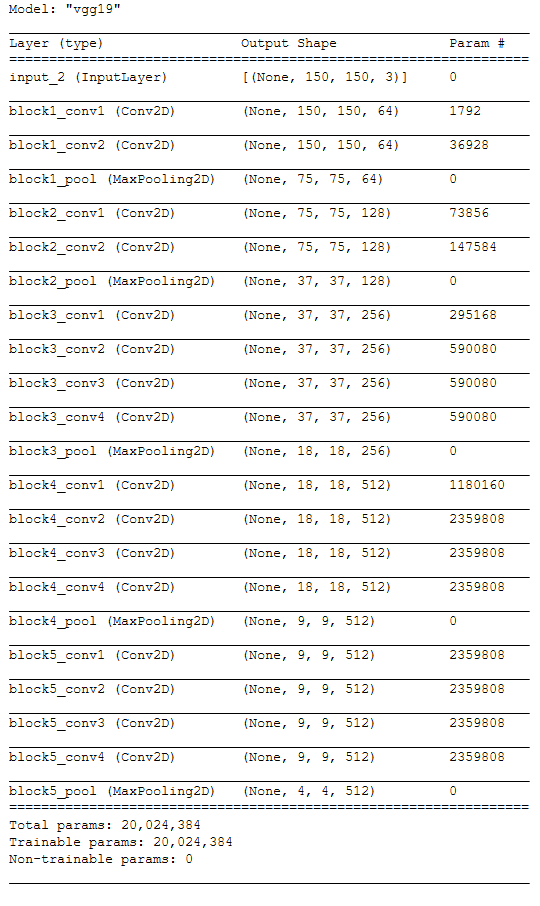
4.4 Freezing all layers up to a specific one
How is this post here different from CNN with Transfer Learning? Up to this point not at all! But right here we can make a setting, which we have not made before. Until now we had all conv blocks always frozen (see here). Now we set all parameters to trainable with conv_base.trainable = True. But of course (otherwise we wouldn’t have to do any transfer learning) we want to keep most of the already learned features. So we have the possibility to freeze a part of the conv blocks or to leave a part unfrozen.
With the following code we can freeze all layers up to ‘block5_conv3’. Thus, in this example, only the weights of the last two conv layers (block5_conv3 and block5_conv4) are adjusted using our training data.
conv_base.trainable = True
set_trainable = False
for layer in conv_base.layers:
if layer.name == 'block5_conv3':
set_trainable = True
if set_trainable:
layer.trainable = True
else:
layer.trainable = False4.5 Instantiating a densely connected classifier
4.5.1 Layer Structure
model = models.Sequential()
model.add(conv_base)
model.add(layers.Flatten())
model.add(layers.Dense(256, activation='relu'))
model.add(layers.Dense(1, activation='sigmoid'))model.summary()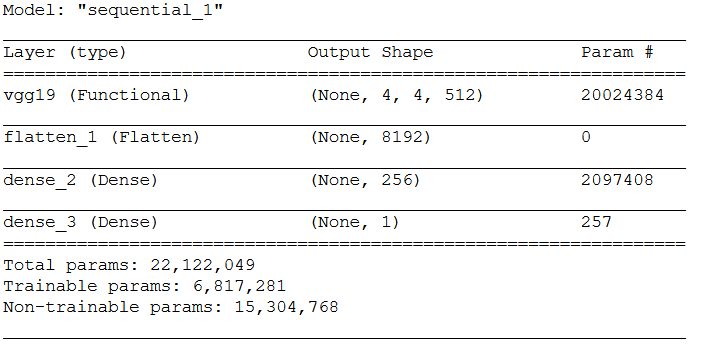
4.5.2 Configuring the model for training
model.compile(loss='binary_crossentropy',
optimizer='adam',
metrics=['accuracy'])4.5.3 Using ImageDataGenerator
train_datagen = ImageDataGenerator(
rescale=1./255,
rotation_range=40,
width_shift_range=0.2,
height_shift_range=0.2,
shear_range=0.2,
zoom_range=0.2,
horizontal_flip=True,)
validation_datagen = ImageDataGenerator(rescale=1./255)
train_generator = train_datagen.flow_from_directory(
train_dir,
target_size=(img_height, img_width),
batch_size=n_batch_size,
class_mode='binary')
validation_generator = validation_datagen.flow_from_directory(
validation_dir,
target_size=(img_height, img_width),
batch_size=n_batch_size,
class_mode='binary')
4.6 Callbacks
# Prepare a directory to store all the checkpoints.
checkpoint_dir = checkpoint_no
if not os.path.exists(checkpoint_dir):
os.makedirs(checkpoint_dir)keras_callbacks = [ModelCheckpoint(filepath = checkpoint_dir,
monitor='val_loss', save_best_only=True, mode='auto'),
EarlyStopping(monitor='val_loss', patience=5, mode='auto',
min_delta = 0, verbose=1)]4.7 Fitting the model
history = model.fit(
train_generator,
steps_per_epoch=n_steps_per_epoch,
epochs=n_epochs,
validation_data=validation_generator,
validation_steps=n_validation_steps,
callbacks=keras_callbacks)
4.8 Obtaining the best model values
hist_df = pd.DataFrame(history.history)
hist_df['epoch'] = hist_df.index + 1
cols = list(hist_df.columns)
cols = [cols[-1]] + cols[:-1]
hist_df = hist_df[cols]
hist_df.to_csv(checkpoint_no + '/' + 'history_df_' + model_name + '.csv')
hist_df.head()
values_of_best_model = hist_df[hist_df.val_loss == hist_df.val_loss.min()]
values_of_best_model
4.9 Obtaining class assignments
class_assignment = train_generator.class_indices
df = pd.DataFrame([class_assignment], columns=class_assignment.keys())
df_stacked = df.stack()
df_temp = pd.DataFrame(df_stacked).reset_index().drop(['level_0'], axis=1)
df_temp.columns = ['Category', 'Allocated Number']
df_temp.to_csv(checkpoint_no + '/' + 'class_assignment_df_' + model_name + '.csv')
print('Class assignment:', str(class_assignment))
4.10 Validation
acc = history.history['accuracy']
val_acc = history.history['val_accuracy']
loss = history.history['loss']
val_loss = history.history['val_loss']
epochs = range(1, len(acc) + 1)
plt.plot(epochs, acc, 'bo', label='Training acc')
plt.plot(epochs, val_acc, 'b', label='Validation acc')
plt.title('Training and validation accuracy')
plt.legend()
plt.figure()
plt.plot(epochs, loss, 'bo', label='Training loss')
plt.plot(epochs, val_loss, 'b', label='Validation loss')
plt.title('Training and validation loss')
plt.legend()
plt.show()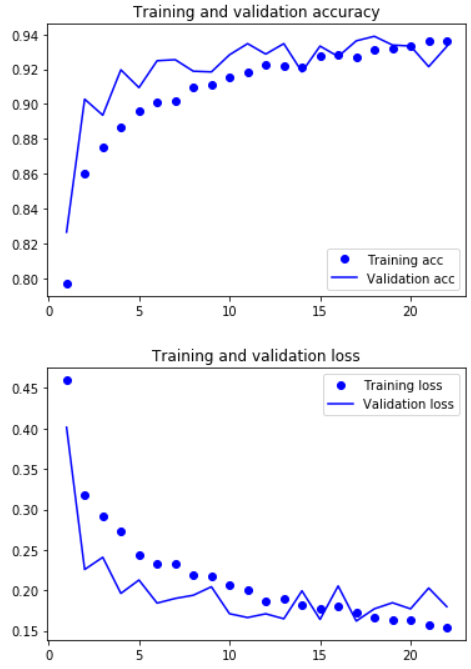
4.11 Load best model
# Loading the automatically saved model
model_reloaded = load_model(checkpoint_no)
# Saving the best model in the correct path and format
root_directory = os.getcwd()
checkpoint_dir = os.path.join(root_directory, checkpoint_no)
model_name_temp = os.path.join(checkpoint_dir, model_name + '.h5')
model_reloaded.save(model_name_temp)
# Deletion of the automatically created folders/.pb file under Model Checkpoint File.
folder_name_temp1 = os.path.join(checkpoint_dir, 'assets')
folder_name_temp2 = os.path.join(checkpoint_dir, 'variables')
file_name_temp = os.path.join(checkpoint_dir, 'saved_model.pb')
shutil.move(file_name_temp, folder_name_temp1)
shutil.rmtree(folder_name_temp1, ignore_errors=True)
shutil.rmtree(folder_name_temp2, ignore_errors=True)best_model = load_model(model_name_temp)4.12 Model Testing
test_datagen = ImageDataGenerator(rescale=1./255)
test_generator = test_datagen.flow_from_directory(
test_dir,
target_size=(img_height, img_width),
batch_size=n_batch_size,
class_mode='binary')
test_loss, test_acc = best_model.evaluate(test_generator, steps=n_test_steps)
print()
print('Test Accuracy:', test_acc)
pk.dump(img_height, open(checkpoint_dir+ '\\' +'img_height.pkl', 'wb'))
pk.dump(img_width, open(checkpoint_dir+ '\\' +'img_width.pkl', 'wb'))Our final folder structure now looks like this:
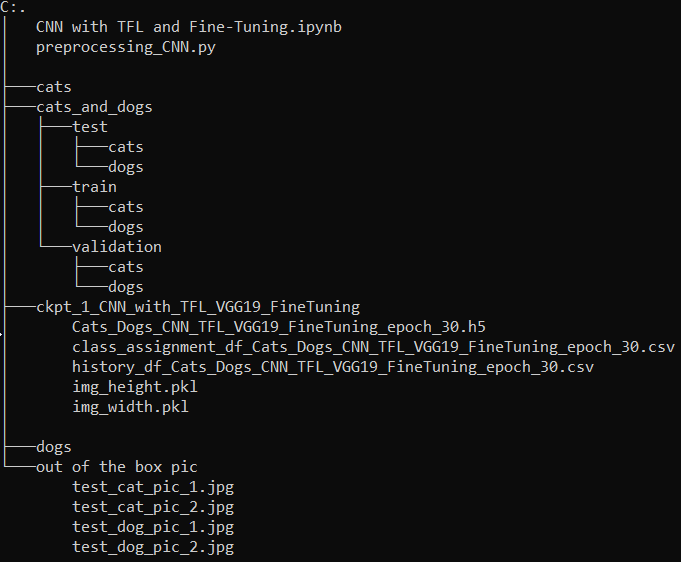
4.13 Test Out of the Box Pictures
# Determine Checkpoint Dir
checkpoint_dir = 'ckpt_1_CNN_with_TFL_VGG19_FineTuning'
# Load best model
best_model = load_model(checkpoint_dir + '/' + 'Cats_Dogs_CNN_TFL_VGG19_FineTuning_epoch_30.h5')
# Load the categories
df = pd.read_csv(checkpoint_dir + '/' + 'class_assignment_df_Cats_Dogs_CNN_TFL_VGG19_FineTuning_epoch_30.csv')
df = df.sort_values(by='Allocated Number', ascending=True)
CATEGORIES = df['Category'].to_list()
# Load the used image height and width
img_height_reload = pk.load(open(checkpoint_dir + '/' + 'img_height.pkl','rb'))
img_width_reload = pk.load(open(checkpoint_dir + '/' + 'img_width.pkl','rb'))
print('Model Summary :' + str(best_model.summary()))
print()
print()
print('CATEGORIES : ' + str(CATEGORIES))
print()
print('Used image height: ' + str(img_height_reload))
print('Used image width: ' + str(img_width_reload))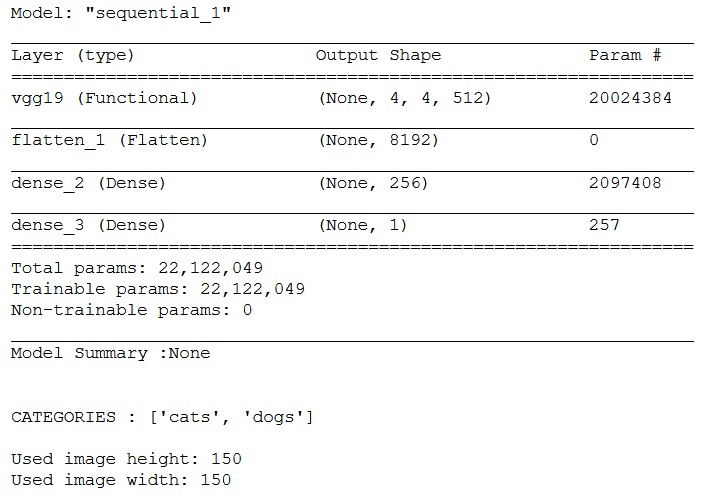
img_pred = cv2.imread('out of the box pic/test_cat_pic_1.jpg')
print(plt.imshow(cv2.cvtColor(img_pred, cv2.COLOR_BGR2RGB)))
img_pred = cv2.resize(img_pred,(img_height_reload,img_width_reload))
img_pred = np.reshape(img_pred,[1,img_height_reload,img_width_reload,3])
classes = (best_model.predict(img_pred) > 0.5).astype("int32")
print()
print('------------------------------------')
print('Predicted Class: ' + CATEGORIES[int(classes[0])])
print('------------------------------------')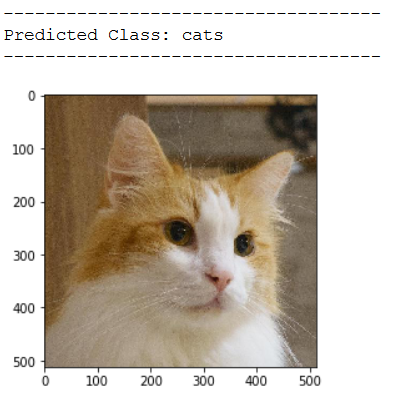
img_pred = cv2.imread('out of the box pic/test_cat_pic_2.jpg')
print(plt.imshow(cv2.cvtColor(img_pred, cv2.COLOR_BGR2RGB)))
img_pred = cv2.resize(img_pred,(img_height_reload,img_width_reload))
img_pred = np.reshape(img_pred,[1,img_height_reload,img_width_reload,3])
classes = (best_model.predict(img_pred) > 0.5).astype("int32")
print()
print('------------------------------------')
print('Predicted Class: ' + CATEGORIES[int(classes[0])])
print('------------------------------------')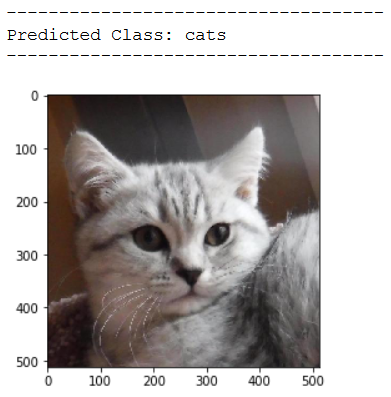
img_pred = cv2.imread('out of the box pic/test_dog_pic_1.jpg')
print(plt.imshow(cv2.cvtColor(img_pred, cv2.COLOR_BGR2RGB)))
img_pred = cv2.resize(img_pred,(img_height_reload,img_width_reload))
img_pred = np.reshape(img_pred,[1,img_height_reload,img_width_reload,3])
classes = (best_model.predict(img_pred) > 0.5).astype("int32")
print()
print('------------------------------------')
print('Predicted Class: ' + CATEGORIES[int(classes[0])])
print('------------------------------------')
img_pred = cv2.imread('out of the box pic/test_dog_pic_2.jpg')
print(plt.imshow(cv2.cvtColor(img_pred, cv2.COLOR_BGR2RGB)))
img_pred = cv2.resize(img_pred,(img_height_reload,img_width_reload))
img_pred = np.reshape(img_pred,[1,img_height_reload,img_width_reload,3])
classes = (best_model.predict(img_pred) > 0.5).astype("int32")
print()
print('------------------------------------')
print('Predicted Class: ' + CATEGORIES[int(classes[0])])
print('------------------------------------')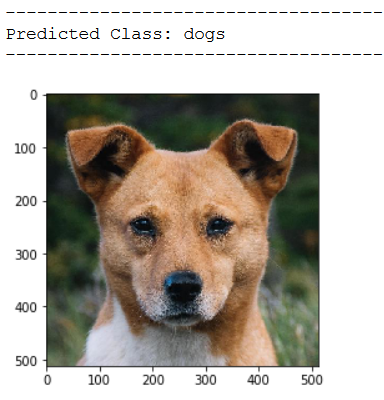
5 Conclusion
That’s it. In this post I showed how you can use transfer learning and fine tuning to bring your model (especially if you have a small amount of training data) to a quite acceptable performance value.
References
The content of the entire post was created using the following sources:
Chollet, F. (2018). Deep learning with Python (Vol. 361). New York: Manning.